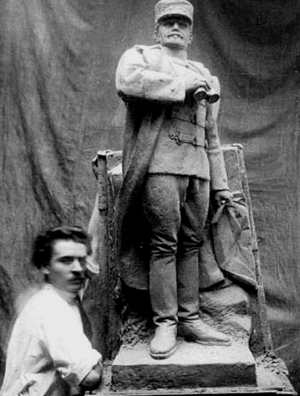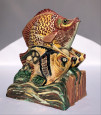Albert-Louis-Edmond Chartier dit Alchar ( - )

Albert Chartier spent his childhood in Blois. His vocation manifested itself early, and his first pictorial work, designated as such by an inscription, is signed 1905, his first bust 1913. Albert Chartier's apprenticeship began at the École Nationale Supérieure des Arts Décoratifs, where he studied under Paul Renouard and met Gio Colucci - alas, only for a short time, as he was drafted in 1916.
Like many of his comrades, he returned from this war experience with the feeling that he had survived unduly, that he had in fact "died at Verdun". Immediately after his demobilization, he began to earn his living by contributing to the construction of numerous war memorials, including the one at Massignac in the Charentes region.
Returning to Paris in 1921, he was admitted to the École Nationale des Beaux-Arts. He remained there until 1927. It was here that the tradition of classical sculpture was perpetuated in Paris. He studied with Jules Coutan and Paul Belmondo, among others. He also attended Jean-Antoine Injalbert's workshop.
The immediate recognition of his skills, which earned him a gold medal at the 1925 Salon des Arts Décoratifs, and a certain critical success, rapidly secured him commissions, mainly in his native region. Albert Chartier remained associated with a regionalist group in Blois known as the École de la Loire. His most productive period was from 1925 to 1950.
His career as a sculptor of busts was coupled with his work as a sculptor for the Monuments Historiques. Very active on the region's major restoration projects, he created the sculpture in the grand staircase of the Gaston d'Orléans wing for Alphonse Goubert and Paul Robert-Houdin at the Château de Blois. He also worked on Blois Cathedral, Saint-Vincent Cathedral and, above all, Orléans Cathedral, where he worked on its restoration from 1941 to 1959. At the same time, Albert Chartier embarked on another career, no doubt for economic reasons, which gradually distanced him from public commissions: he became a sculptor for the Musée Grévin.
He also left a large body of pictorial work, with sketches, drawings and paintings accompanying his work as a sculptor, albeit in a preparatory capacity. This work also bears witness to his taste for travel, which in his youth had taken him to Italy and Tunisia, but which he indulged in many places throughout his life. In his pictorial art, he gives the impression of a freedom that he undoubtedly did not allow himself in his sculptural work. His talent as a colorist unfolded freely, less subject to the constraints of classical form, as if color allowed him a new freedom and led him to question the requirements of figurability.
This artist's work clearly illustrates the aesthetic conflicts faced by artists in the 1930s, and how their work evolved, caught between tradition and modernity, loyalty to the values handed down by their masters and academies, and attraction to the formal renewal that was taking place all over the world, brought to Paris by numerous émigré artists such as Pablo Picasso and Ossip Zadkine, whose achievements and aesthetic interrogations broke with the classical training of their countries of origin.
